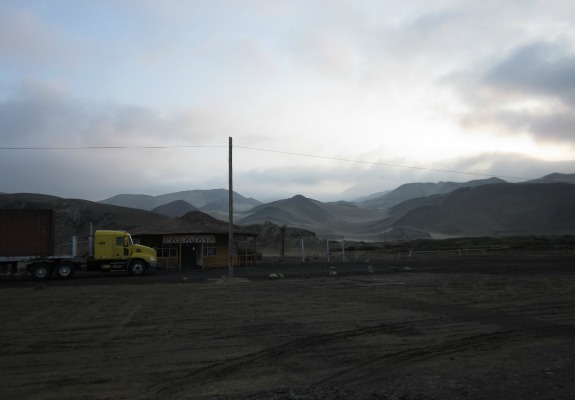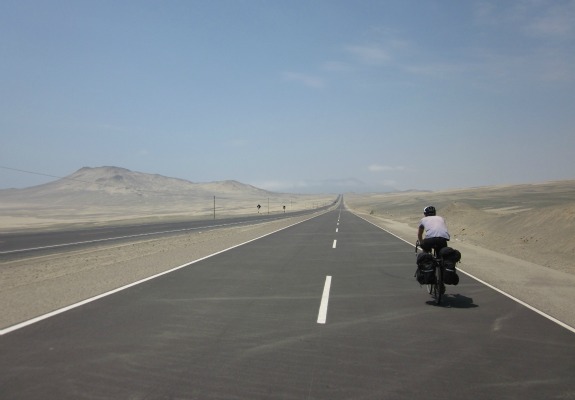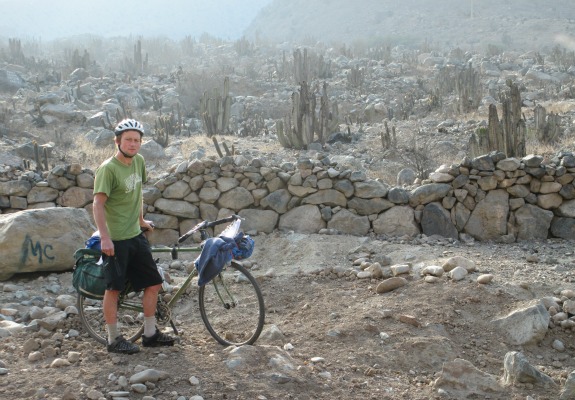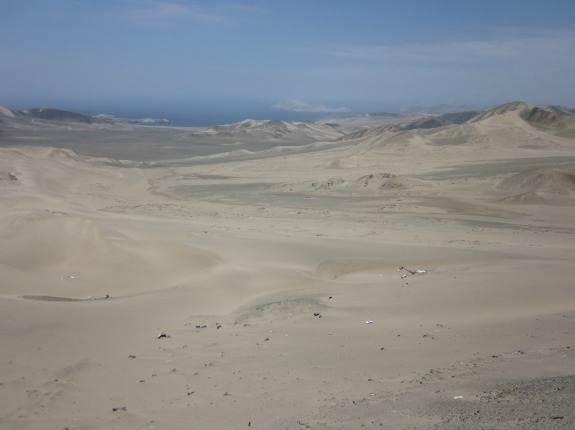No Place Compares to the Unrelenting Lifelessness of Peru’s Sechura Desert
From tropical mountains, we descended into a landscape of flailing-armed cacti, spiny succulents like giant artichokes and sand dunes as high as mountains
The sight of the Sechura Desert highway vanishing in the dreary distance would crush cyclists if they weren’t assisted by a supreme northward tailwind. Photo by Alastair Bland.
The cyclist who comes to Peru having heard warnings about malaria, rain and polluted water may be as alarmed as I was as we descended from the mountains into a landscape of flailing-armed cacti, spiny succulents like giant artichokes and sand dunes like mountains. Peru’s coast is home to one of the most barren, most imposing deserts I have seen. No place in Greece or Turkey compares in dryness, and even other bona fide deserts, like the cacti wonderland of Baja California or the shrubby sprawl of the Kalahari, cannot match this one—called the Sechura Desert—in sheer lifelessness.
As we crested out at sea level and began our northward advance along the Pan-American Highway, fantastic scenery unfurled—miles and miles of sprawling sand hills, some of the dunes hundreds of feet high, and running all the way from the eastern horizon to the ocean. In places, settlements of inhabited shacks clung to the mountainsides, with rags, bags and torn burlap flapping in the wind. We have come more than 200 miles in two days on the coast, and for much of that distance we have seen not a living blade of grass—just barren scorched rock and dunes. We saw four huge, soaring vulture-like birds yesterday that may have been condors, a few dogs and too many roadside human memorials to count—the sad reminders of traffic deaths. We know the land will turn green eventually, as we have heard Ecuador is a tropical haven, and we’re anticipating that transition. So far the desert shows no signs of relenting, outside of occasional green and irrigated valleys of mango and avocado orchards.
The Sechura Desert is truly an anomaly of a place. Look at the other great deserts of the world. There is the Atacama of Chile, the Kalahari of southern Africa, the giant Sahara of northern Africa, the Mexican-American Sonoran Desert and the great desert of Australia. For all their distinguishing points, these regions all have one prominent feature in common—their latitude. Each one is situated between about 20 and 30 degrees south or north of the Equator. This is no coincidence. Rather, this latitude zone is simply where deserts happen. It’s a function of wind patterns and sun, high pressure and a persistent absence of cloud formation. (There are a few exceptions to this global pattern—namely the mid-continent, high-latitude deserts of Asia and the American West, these areas denied water largely due to their distance from the sea and moisture sources.)
But the Sechura Desert lies between about 5 and 15 degrees latitude south. Why? The Andes. They tower just a few miles to the east, 15,000 to 20,000 feet high all the way from Ecuador to central Chile, creating in certain places what geographers call a rain shadow. That is, air coming from the east via the trade winds waters the Amazon basin generously, as well as the east-facing slope of the Andes. Here, the air rises and cools. Condensation occurs, and clouds drench the mountains. But as that air begins to descend on the west face, cloud formation halts as the air warms. Rainfall ceases. And at sea level, there is a desert, waiting for the water that rarely arrives. The Sechura receives just ten centimeters of precipitation each year in parts.

Mountainous sand dunes sprawl into the east behind this Pan-American Highway truck stop. Photo by Alastair Bland.
The beauty of this place is fleeting yet very real in an almost horrifying way. Thankfully, we have had a screaming tailwind for days. Yesterday, we averaged almost 15 miles per hour—great time on loaded bicycles. At about 3 p.m. we passed Paramonga, a town that probably would have had a cheap hotel or campground. But it was too early to quit. “Should we get water?” Andrew suggested. “We have two liters, and we’ll hit another town before long,” I said. But we didn’t. About three hours later, a road sign told us that the next big town—Huarmey—was still 75 kilometers ahead. The afternoon shadows grew longer and the road continued seemingly without end. In places, it shot ahead like an arrow—as often as not uphill. We began to tire, and we wondered where we would sleep, and whether we would have dinner. At last, after ten miles of unhappy silence between us, we saw a truck stop ahead. It was a cluster of restaurants and grocery shacks. We bought water first, then purchased the only onsite food that we considered safe from microbial dangers—beer. A truck driver eating dinner observed our obvious hunger, went outside to his truck and produced a bag of apples and peaches. We thanked him profusely, then thought about bed. It was too late to continue, and we asked the owner of one of the café shacks if we could camp out back. Without a thought, he waved us in. He and his family lived without running water on a bare earth floor. In back, in a yard of trash and blown sand, was a small clay and wood shack. ”How much?” we asked. He waved away the mention of money. We settled in, had our beers and fruit, and read our books until we nodded off. We learned our lesson and will keep a supply of water and food available. I am not afraid of sleeping in the wild, but to finish 100 miles without a dinner is not my favorite sort of suffering.
We took a break at the beach for a morning in Tortugas, a beautiful bay on the Pacific ringed by rocky shores and cliffs and restaurants. We went for coffee at the El Farol Hostal and chatted with our waiter about local fish species, diving, spearfishing, the average visibility in the water and other elements of the seascape. He told us the water is cold enough to require wetsuits—even just several degrees from the Equator. He also said halibut live here—a pleasant surprise for Californians who grew up pursuing the local rendition of the fish. We wished we had time to stay in Tortugas, but we’ve discovered that cycling from Lima to Quito in 20 days means booking it in high gear.
Aside from scattered moments of rest and joy with coffee or mangoes or lucumas on a plaza bench in the shade, the nonstop tailwind is our chief joy out here. Yesterday, as we went the last 15 miles to the town of Casma, we rode for five full kilometers on level ground without pedaling at all, watching with laughter as each kilometer marker came sailing past. I’ve never known a wind to fly so forcefully, so directly along a roadway as this wind does. We have made incredible time with the southerly in our favor, and we’re especially glad to see this desert go by, although at scattered vista points we can’t help but stop and remark that this lifeless, endless landscape is amazing to see. But the desert is wearing us down—especially the daily skirmishes we have with each big town. These are nightmares of congestion, dust and discomfort. Consider one recent image seared into my mind: On a hot, windy day in Huacho, we were battling the frantic heat and dust, looking for a fruit market and dodging the aggressive three-wheeled moto-taxis. Then, across the raging boulevard, I caught a glimpse of a girl, seated, holding a smaller child in her arms. The bigger girl’s head hung in despair—and I noticed then that the smaller girl sagged limply from head to toe. Scores of people were walking past. Wasn’t anyone going to help them? I wasn’t sure what to do. Somewhere else I would have stopped immediately—but here, in Huacho, Peru, four lanes of snarling traffic separated us from the girls. Neither Andrew nor I had a cell phone, spoke fluently in Spanish or knew where a hospital was. A moment later, a blast of heat and dust from a passing bus swept the sight from mind, and we continued forward, battling the streets in defense of our own lives, and hunting for a watermelon.
/https://tf-cmsv2-smithsonianmag-media.s3.amazonaws.com/accounts/headshot/Off-Road-alastair-bland-240.jpg)



/https://tf-cmsv2-smithsonianmag-media.s3.amazonaws.com/accounts/headshot/Off-Road-alastair-bland-240.jpg)